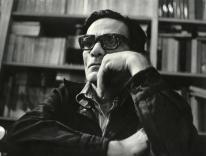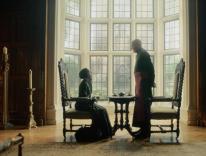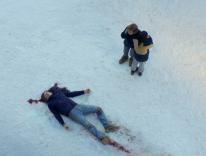All of us recreate in our memories the books we’ve read, but children do this drastically, sometimes adding scenes that simply aren’t there in the text or greatly expanding brief ones. Director Andrew Adamson has candidly admitted that with his second go at the Narnia chronicles, Prince Caspian, he filmed the story he remembered from childhood rather than the one C. S. Lewis wrote. The result is an uneven movie that I found often exciting and just as often boring. Judging by the alternation of raptness and restiveness among the kids around me (plenty of trips to the concession counter but total silence during the action scenes), children are finding it exciting and boring, too.
Each of the Narnia books has its special character. If The Lion, the Witch, and the Wardrobe projects the wintry spell of Hans Andersen’s Snow Queen, Prince Caspian is a compound of Thomas Mallory and Beatrix Potter: talking squirrels and knights, talking mice who are knights, besieged castles and walking trees (this last may be an homage to Lewis’s friend, Tolkien), wizards offering sage advice, and badgers offering hot drinks in cozy caves. And since Lewis is an unabashedly eclectic storyteller, there are also centaurs and maenads. But, though some of the creatures may be from Greek mythology, none of the war scenes is Homeric. The author keeps the battles mostly offstage and even the climactic single combat is shown through the eyes of onlookers. Lewis keeps the action intimate because his theme is intimate: We must have faith especially when external events seem to refute our faith. The presiding, cautionary spirit here is St. Thomas, the doubting apostle.
But Andrew Adamson apparently remembered the book as a medieval epic and has mounted it as a sort of Henry V for children or a compact version of The Lord of the Rings. The last third of this 140-minute movie is a succession of sieges, raids, pitched battles on the grandest scale, complete with catapults and flying thickets of arrows, parleys within pavilions, and riders tearing through forests on rescue missions. And the fact that the director has gorgeously photographed parts of the movie in New Zealand (with hurtling overhead shots that make the beaches look like just so much mocha frosting) makes Caspian a visual sibling of Peter Jackson’s Tolkien adaptations.
And, I confess, it was just when this film most resembled Lord of the Rings or Henry V that I most enjoyed it. Critics nowadays profess (or pretend) to be bored by CGI (computer-generated imagery), but all I care about are results, and if it’s CGI that delivers the cinematic goods, fine. In the battles, here, I loved the way Anderson pictured Caspian’s animal allies taking advantage of their own physicality: squirrels and mice using their littleness to scramble under a portcullis, giant eagles serving as aircraft, walking trees employing their branches as giant pincers, centaurs leading the cavalry charge. The Thomas Mallory side of Lewis is well served, even if the Christian undercurrents are skimped on.
Quite damaging, though, is Adamson’s insistence on prolonging the movie as if to match the epic quality of the combat. Lewis thought of his Narnia books as fairy tales, not epics, and so he kept the narrative condignly compact. The first half of Caspian has a split focus: while Caspian escapes from his treacherous uncle and recruits his army, the Pevensie children are magically swept back to Narnia, discover its calamitous state of affairs, and wend their way to Caspian’s aid. Lewis manages all this without longueurs, but the film’s first half is full of them. Too much scenery, adolescent angst, sylvan wandering; too many tableaux with surging music trying to make up for inadequate staging, and too many pseudo-Hamlet musings by Caspian that come to nothing because they have no solid grounding in the story. Lewis liked the fairy tale form because of “its brevity, its severe restraints on description...its inflexible hostility to all analysis, digression, reflections, and ‘gas.’” There’s way too much “gas” in this adaptation, which results in tedium.
But the concluding battles are worth waiting for, and so is Tilda Swinton’s two-minute reappearance as the White Witch. Please, Andrew Adamson, make The Magician’s Nephew as soon as possible, so we can have more Tilda Swinton.
What has happened to the memories of film critics? A plague of amnesia? How else to explain the critical consensus that Indiana Jones and the Kingdom of the Crystal Skull is a disappointment and a falling off from the high standards set by the previous Indianas? Have any of the complainers looked at the rest of the series lately? If they had, they would surely realize that Crystal Skull is the perfect plateau, not one bit better, not one whit worse. It’s a retread, but the very first installment was a retread-of 1930s and 1940s Saturday kids’ matinee serials.
What you got before, you get again: the same ridiculous set-up for an adventure-filled quest, the same neglect to make the object of the quest fascinating in itself (because it’s only a “McGuffin,” an excuse for the ensuing fantasy), the same superbly choreographed and edited fights/escapes, the same gross-out deaths for villains (this time, a Soviet thug is inundated by an army of red ants-cool!), the same beautiful, icy villainess (Cate Blanchett amusing herself with a Russian accent from outer space), the same plucky heroine (literally the same as Raiders of the Lost Ark’s-Karen Allen, looking amazingly well preserved while presenting Indie with his grown son and a chance to finally marry her).
The premise has something to do with ancient godlike visitors to earth, which Steven Spielberg and George Lucas have cribbed from Chariot of the Gods, though the aliens here aren’t from another planet but from a time-space dimension parallel to ours (sort of like Narnia, come to think of it). But, as usual with this series, the real raison d’être is the action, mounted and cut with Spielberg’s usual virtuosity. Watching them, the logical part of your brain tells you that each set piece took weeks to stage, while your eyes and viscera say that the stunts are taking place all at once before your eyes, like a circus performance, and that the camera, seemingly mounted on a trapeze, is swinging back and forth between Indie fighting bad guys on one side of a truck and his son fencing with the villainess on the other, while Karen Allen is driving that truck along the edge of a cliff, etc. This illusion of simultaneity and continuousness, as Pauline Kael once remarked, makes the viewer forget to blink.
Most of today’s movie reviewers were in their late adolescence or early twenties when the first Indiana Jones film was made. Like greedy kids crowding around Willy Wonka as he ladles out mounds of expensive chocolate, they oohed and aahed at the cinematic candy Spielberg flung at them. The same critics, now middle aged and coming down with diabetes, complain that the feast is no longer fresh and lacks nutritional value. But when was candy ever nutritious? Are these critics mourning a temporary fizzle of Spielberg’s talent or are they mourning their lost youth?
Please email comments to [email protected] and join the conversation on our Facebook page.
Share
Previous Story
A Political Prisoner
Next Story
JPII priests, secularism & more


